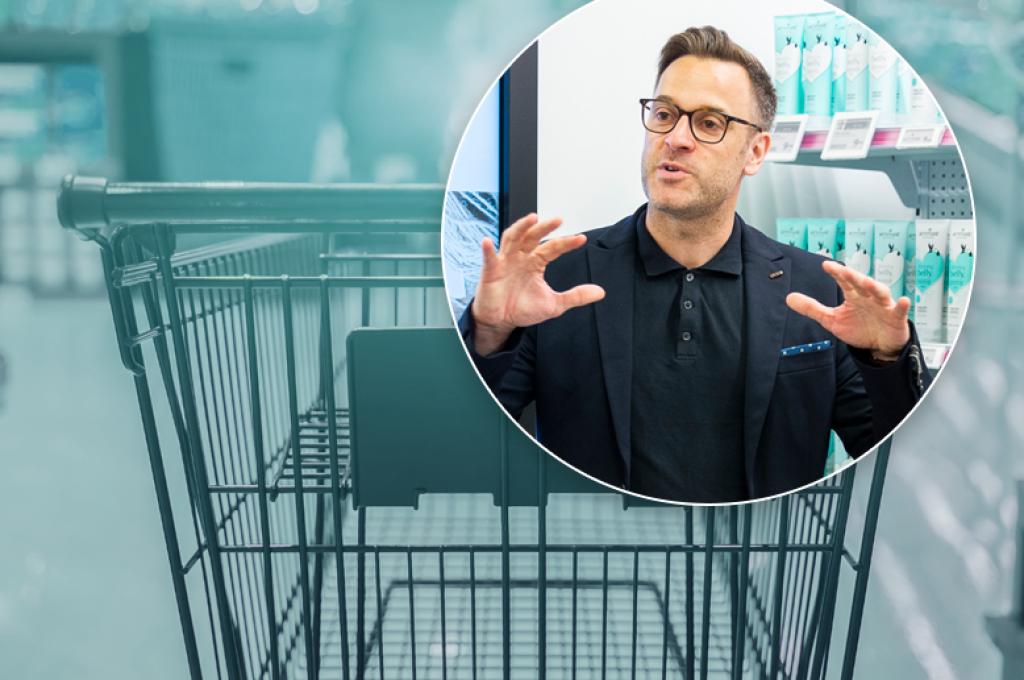Are you a fan of second-hand? An e-commerce addict? Sceptical about the obsolescence of objects? Université du Québec à Montréal researcher, Fabien Durif, studies these consumer behaviours in a laboratory converted into a one-of-a-kind experimental store called the GreenUXlab. And he’s using those insights to learn how purchasing habits have changed during the pandemic. We spoke to Durif to find out how.
CFI: Could you share the key steps that allowed GreenUXlab to see the light of day?
Durif: In 2010, while I was at the Université de Sherbrooke, I co-founded the Observatoire de la consommation responsable, which was intended to be a research and strategic monitoring cell.
The idea of the experimental store came from a study that we’d conducted on ecolabels and green positioning strategies in the household cleaning products sector in Quebec.
Then, to demonstrate the interest and need to create this type of infrastructure in Canada, it was quite crucial that I visit several types of experimental stores and identify their operating method. This is what I had the chance to do by visiting France, the U.K., Italy and Japan.
This turned out to be a relatively lengthy process. Then, in 2016, it was through a CFI grant that the GreenUXlab was created.
CFI: Specifically, what is the purpose of this experimental store?
Durif: The main objective of this first experimental store in Canada is to explore three key areas of research in responsible consumption: translating the intention-behaviour gap into general recommendations; knowing how to communicate the environmental information of goods; and assessing the potential of new technologies in communicating this information.
The challenge is to transfer information to the general public and to small- and medium-sized businesses across Quebec and Canada to help them address the current issues they face. Today, the GreenUXlab is what I refer to as a unique ecosystem for device testing, co-creation, research and innovation.
The store’s 700 square feet house all types of specialized equipment, such as active and passive radio frequency identification sensors and readers, Bluetooth Low Energy scanners, touchscreens and non-touchscreens, a virtual mirror, a 3D body scanner, and connected charging stations. We also use Light-Fidelity technology and geolocation tools. There is a team of more than 15 researchers and research assistants.
CFI: Who benefits from your research?
Durif: We’re involved at various levels, but always from a scientific research standpoint. As much as possible, we transfer our research by making tools available that meet the public and professionals’ needs. For example, to encourage economic recovery post-COVID-19, we are attempting to provide relevant information regarding the impact of the crisis on the economy and the future of consumption.
In light of the unprecedented health, social and economic crisis that we’re experiencing, we put out the Vigie Conso COVID-19, which involves 40 daily consumer watch posts, 10 weekly posts and two monthly posts. This is what has led us to be actively involved in the Chantiers sur l’avenir du commerce de détail au Québec initiative spearheaded by Le Panier Bleu.
CFI: Do you think there will be an economic recovery?
Durif: The recovery should follow, but the whole point of our studies is precisely to evaluate whether or not, particularly during the lockdown, there were changes in consumption habits and whether or not they will last over time. E-commerce aside, what emerges is a growing popularity for buying local and a curtailing of lifestyles, specifically with the increase of certain practices, such as “DIY.” We put into perspective this data, which we transmit in the form of hypotheses and recommendations.
CFI: Who are you trying to reach with these recommendations?
Durif: We work directly with retailers and manufacturers who, for the most part, don’t have the financial means to integrate technology into their processes or the time to conduct actual large-scale experiments with consumers. Often, we start off with qualitative steps and quantitative pre-tests in the CFI laboratory.
Then, we finalize these findings using online experiments and create surveys via our consumer panels. For example, we have a long-term partnership with Attitude [a Canadian body care company]. We keep the full line of all their brand’s products in order to run tests related to the research programming. Recently, a master’s student submitted her thesis based on an experiment she ran in collaboration with the brand on the issue of “without” and “with” claims for cosmetic products.
In some cases, depending on the type of collaboration agreement, we share the test results with our partners. Accordingly, they may review their labelling of a given product or their managerial practices, promote communications on social media platforms, or prioritize their environmental practices in a different manner. This will help their strategies evolve.
Moreover, we are conducting various studies with key players in the Quebec retail sector and developing training sessions on point-of-sale trends in buying local and socially responsibly.
That’s why I refer to it as an ecosystem!
CFI: If a retailer asked you for advice, what would you tell them?
Durif: It is imperative to revitalize retail. Brands and banners that do not commit to the collaborative, second hand, DIY and buying-local path ultimately risk being affected. Even though this may be complex, adapting to new trends and innovation has become unavoidable.
Regarding this subject, the Canadian market is somewhat falling behind compared to Europe or Asia. In France, certain banners have, over the past few years, developed pick-up locations for pedestrians, for example.
The COVID-19 crisis has also emphasized the need to have an online presence, to be efficient regarding delivery and to multiply the points of contact with customers, which is what we refer to as omnichannel. Add this to the new, more socially responsible consumer trends, and we see that it can represent quite a daunting challenge; however, there is a single watchword: Adapt!
CFI: If we push this comparison even further, what other noticeable difference do you see between Canada and other countries?
Durif: We’re not in the same market at all. Regarding social responsibility, France and the U.K. are countries where legislative progress is remarkable. I’m thinking of the Energy Transition for Green Growth Act in France or obsolescence laws.
In Canada, while the entrepreneurial ecosystem is highly innovative, there isn’t much regulation. Nothing can replace a regulatory framework that enlightens citizens and gives them the option of making more informed choices.
CFI: What sets GreenUXlab apart and makes you proud?
Durif: The difference in our model is that it straddles the line between a university model and a model that I would call “external.” Generally, experimental stores are either “closed,” meaning that they operate only inside of a university and conduct tests with their students and, as such, their vocation is primarily educational; or, they’re stores that belong to international research firms, large retailers or private groups, with limited sharing of and access to data.
Our ecosystem is unique and synergistic. We have different types of research environments. The laboratory welcomes private-sector actors; it also opens its doors to researchers such as my colleague Ygal Bendavid of The Internet of Things Laboratory. Yet we also go beyond the framework of an on-site laboratory and propose collaborations with all the members of the university community. I’ve yet to see this type of store in any other university.
According to Fabien Durif, adapting is not as easy as you think, but it’s essential. Learn more about this researcher by listening to these clips from our conversation with him. (These audio clips are available in French only.)
Transcript of Fabien Durif’s response:
No, I think that actually research does not lack creativity at all because the knowledge transfer can come in many forms: indexes, barometers, capsules, videos, media responses and then events. As a personal example, in our laboratory, we conducted, in celebration of the 10th anniversary of the socially responsible consumption barometer, an artistic design experiment based on socially responsible consumption. We’d never done this type of event. We collaborated with a visual artist and we sought out an SSHRC collection. So, I feel that today, creation and communication is being seen more and more in every research sector.
What consumer good would you be unable to go without?
Transcript of Fabien Durif’s response:
I think it’s complicated, but, during the pandemic, I think that, like many consumers, it remains Nutella. I know that it’s got too much sugar, and palm oil, and, unfortunately, despite all that, despite the willingness to shift towards a more socially responsible food choice, I think that it’s difficult. And all the studies show that it remains one of the most consumed products. So, yes, it’s a guilty pleasure.
How do you define innovation?
Transcript of Fabien Durif’s response:
It’s pretty complicated to know what innovation is, but I’d say that for us, it’s the ability to be ahead of the curve and to anticipate a specific need, specifically in management. And I think that within the CFI research infrastructure that we have, it’s about collaborating and co-constructing with start-ups. Ultimately, it’s a means of moving towards innovation in research and knowledge transfer.





